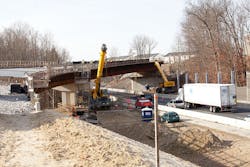Surface transportation investment touted as economic booster
With the highway trust fund (HTF) due to drop near empty by May next year – the sixth time it’s reached that status since 2008 – a new study is being released touting the broad economic benefits from investments in transportation infrastructure and transit systems.
The study – compiled by global consulting firm IHS for the Transportation Construction Coalition (TCC) – analyzed the macro- and microeconomic impacts of both current investments in highway, roadway and bridge infrastructure plus public transit systems as well as what would happen if infrastructure funding were increased.
Some of the report’s findings include:
- Current federal highway and public transit investment, which is about $50 billion annually, will contribute over half a percent to U.S. gross domestic product (GDP) growth over the next 5 years, while supporting 614,000 jobs;
- Current funding levels generates an average $31 billion in personal income tax receipts per year and $6 billion in federal corporate tax receipts per year – amounting to 74 cents returned on every dollar invested;
- Every $1 in federal highway and mass transit investment increases the nation’s GDP between $1.80 and $2.00;
- Current federal transportation spending contributes on average $410 to real income per household each year;
- About 70% of the economic benefits of federal HTF investments in transportation improvements occur in non-construction sectors of the economy;
- Roughly 62% of the jobs created from federal highway and mass transit investments are outside the construction industry; over one-third them in service industries such as healthcare, leisure, and hospitality.
IHS then projected what the economic benefits might be if federal spending on transportation infrastructure and transit got boosted by 5% year-over-year:
- Between 78,000 and 122,000 new jobs would be created by 2019, a figure that includes direct, indirect, and induced jobs;
- It would spur an annual average increase of $40 in real household income each year;
- An additional $9.6 billion in real GDP for the U.S. economy would be added by 2019;
- On average that additional investment would generate an additional $4.9 billion per year in federal, state and local government tax revenue, without a tax increase.
Pete Ruane, president & CEO of the American Road & Transportation Builders Association (ARTBA) – which is also the co-leading organization for the TCC, comprised of 31 associations and labor union groups – stressed during a conference call with reporters that the “timing of this report’s release is no coincidence.”
He explained that TCC’s study “isolates” the broad economic benefits generated by federal highway and transit spending so as to provide “more ammunition” to get Congress to re-authorize a long-term and more robust surface transportation funding bill.
Chad Moutray, chief economist for the National Association of Manufacturers (NAM), told Fleet Owner during the call that the report illustrates why highway funding needs to be a “priority” for Congress on many levels.
“Manufacturers need good roads as they operate with just-in-time delivery schedules for raw materials and for finished goods, much less roads are how workers get to and from their jobs every day,” he explained.
Moutray also noted that support for infrastructure is one of the few bi-partisan issues where President Obama’s administration and the incoming Republican-controlled Congress can work together. “This is one of the areas where both can find common ground,” he added.
Steve Sandherr, CEO of the Associated General Contractors of America (AGC), added that while the issue of how to fund transportation infrastructure remains a “sticking point” on Capitol Hill, there is widespread agreement that there’s a huge need for more sustainable if not increased levels of funding.
“In legislative terms, that recognition means we’re halfway home to a solution,” he noted.
Roger Dow, president & CEO of the U.S. Travel Association, pointed out another key factor in the TCC study: that focus of transportation funding needs to be on roads.
“We most think of leisure ‘travel,’ most think it’s by air, but in reality, 85% of it goes on rubber wheels,” he said. “This report is really about the roads and delays are growing every day on most of our major roads. That’s impacting how American does business as well as builds global relationships.”
About the Author
Sean Kilcarr
Editor in Chief
Sean Kilcarr is a former longtime FleetOwner senior editor who wrote for the publication from 2000 to 2018. He served as editor-in-chief from 2017 to 2018.
